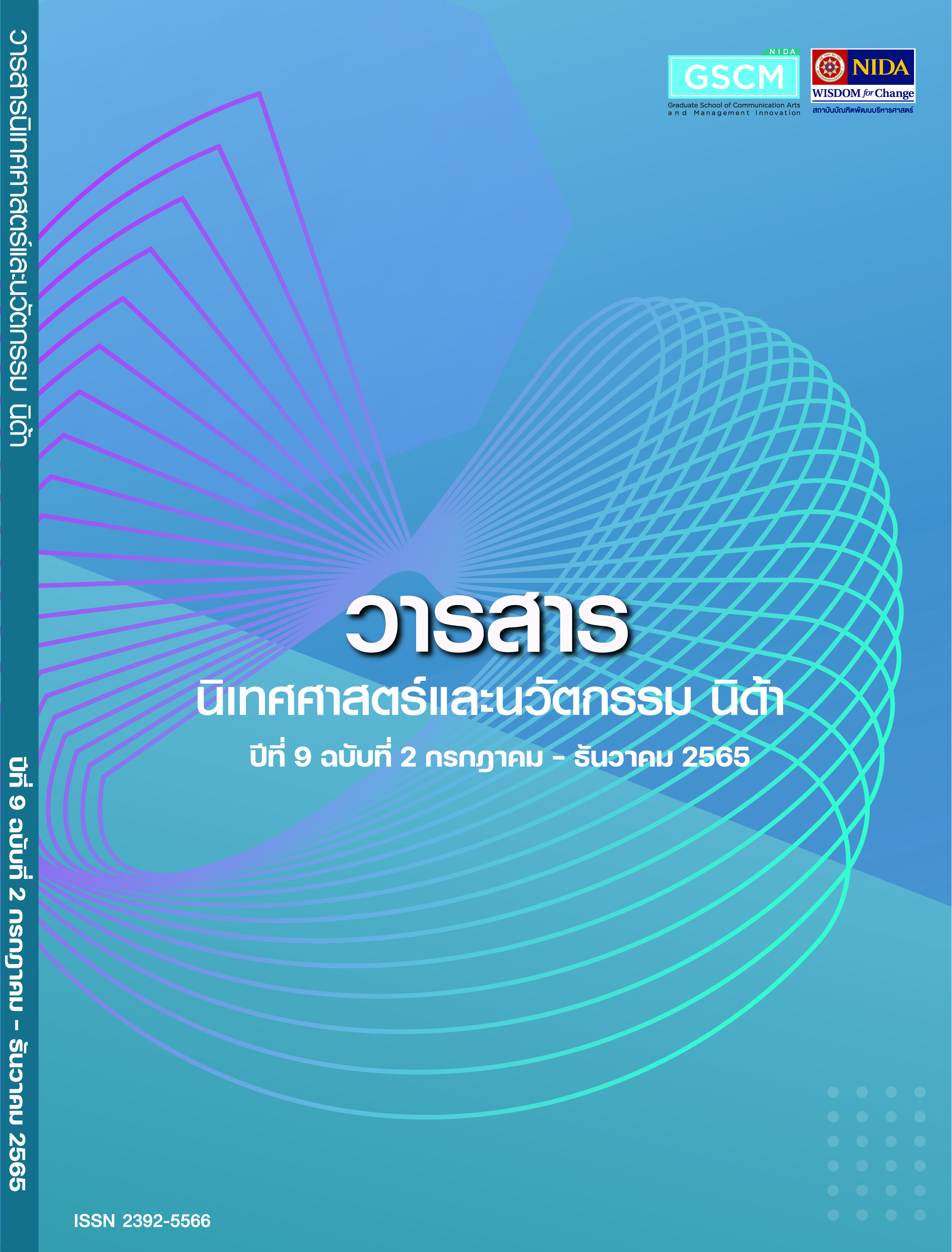Comparison of positive attitude towards art before and after knowing that it was created by an artificial intelligence
Main Article Content
Abstract
This research aimed to compare positive attitude towards art before and after audiences knew that it was created by an artificial intelligence. This is a pre-experimental research in the form of one group pretest-posttest design. The samples were 30 audiences in Bangkok, aged between 19-59 years old, had no skills in art creation, and had an experience of viewing art in the past 12 months. The researchers use non-probability sampling method by using convenience sampling with a questionnaire as a tool.
The results showed that audiences had a positive attitude towards work of art at a higher level than after they knew that it created by an artificial intelligence in which the positive attitude on various issues had noticeably reduced. However, gender variables didn’t affect attitude. Therefore, art-related agencies should plan the communication through communication elements, to make an understanding with audience that how artificial intelligence works in the art space which affected the consideration of beauty and attitude towards art created by an artificial intelligence. For human artists, they can help the art world to have peace by acknowledging that work of art created by artificial intelligence that it was a valuable work and be a kind of artistic expression. Including, the audience should consider work of art more objectively and carefully. Don't let artificial intelligence, work of art creator, as a variable that affects attitudes significantly.
Article Details

This work is licensed under a Creative Commons Attribution-NonCommercial-NoDerivatives 4.0 International License.
ข้อความและความเห็นในวารสารนิเทศศาสตร์และนวัตกรรม นิด้า เป็นของผู้เขียนแต่ละท่าน มิใช่ของคณะนิเทศศาสตร์และนวัตกรรมการจัดการ สถาบันบัณฑิตพัฒนบริหารศาสตร์
References
กิติมา สุรสนธิ, ศุภกิจ แดงขาว และอนงค์ลักษณ์ สมแพง. (2557). ความรู้ทางการสื่อสาร (Introduction to Communication) ฉบับปรับปรุงใหม่. กรุงเทพฯ: คณะวารสารศาสตร์และสื่อสารมวลชน มหาวิทยาลัยธรรมศาสตร์.
ชลูด นิ่มเสมอ. (2557). องค์ประกอบของศิลปะ (พิมพ์ครั้งที่ 9). กรุงเทพฯ: อมรินทร์พริ้นติ้งแอนด์พับลิชชิ่ง.
ตติยา วิชัยดิษฐ. (2563). จริงหรือไม่ที่ Google กำลังสร้าง AI ให้กลายเป็น Skynet#12 AI Dreams. สืบค้นจาก www.repaythailand.com/artificial-intelligence/จริงหรือไม่ที่-google-กำลังสร-12
วัชชิรานนท์ ทองเทพ. (2565). อะไรคือข้อถกเถียงในวงการศิลปะจาก AI หลังกระแส Midjourney. สืบค้นจาก www.bbc.com/thai/articles/c1rexy9d7nyo
วารี ฉัตรอุดมผล. (2551). ศิลปะเพื่อการสื่อสาร. กรุงเทพฯ: คณะวารสารศาสตร์และสื่อสารมวลชน มหาวิทยาลัยธรรมศาสตร์.
วิรัช ลภิรัตนกุล. (2526). การประชาสัมพันธ์ระหว่างประเทศ. กรุงเทพฯ: สำนักพิมพ์แห่งจุฬาลงกรณ์มหาวิทยาลัย.
ศิลปวัฒนธรรม. (2561). ภาพวาดโดยระบบคอมพิวเตอร์ (AI) จะถูกประมูลครั้งแรก เพิ่มคุณค่าหรือโลกศิลป์ถูกคุกคาม? สืบค้นจาก www.silpa-mag.com/news/article_21460
สกนธ์ ภู่งามดี. (2548). ศิลปะปริทัศน์. กรุงเทพฯ: บุ๊ค พอยท์.
สุรพงษ์ โสธนะเสถียร. (2561). สารกับการสื่อความหมาย. กรุงเทพฯ: แดเน็กซ์ อินเตอร์คอร์ปอเรชั่น.
เหมือนฝัน คงสมแสวง. (2562). Media creation. จันทบุรี: มหาวิทยาลัยราชภัฏรำไพพรรณี.
อาศิรา พนาราม. (2559). “ปัญญาประดิษฐ์” ความฝันวัยเด็ก หรือฝันร้ายของโลกอนาคต. ใน Creativities Unfold 2016, Exit to the new reality (น. 60-67). กรุงเทพฯ: ศูนย์สร้างสรรค์งานออกแบบ (TCDC).
ฮักซ์ลีย์, เจ., โบรโนว์สกี, เจ., แบร์รี, เจ., และ ฟิชเชอร์, เจ. (2540). วิวัฒนาการแห่งความคิด: ภาคมนุษย์ และโลก. (จุฑาทิพย์ อุมะวิชนี, ผู้แปล). กรุงเทพฯ: โรงพิมพ์ มหาวิทยาลัยธรรมศาสตร์. (ต้นฉบับ พิมพ์ปี 1966).
allCreativeTeam. (2562). อยู่รอดอย่างไรในยุค 4.0 : ดร.สมเกียรติ ตั้งกิจวานิชย์. สืบค้นจาก www.allmagazineonline.com/อยู่รอดอย่างไรในยุค-4-0/
TUL. (2559). วิเคราะห์สถานการณ์ศิลปะร่วมสมัยในสังคมไทย. สืบค้นจากwww.artbangkok.com/?p=6238
Dignum, V. (2018). Responsible artificial intelligence: designing AI for human values. ITUJournal ICT Discoveries, 1(1), 1-8.
Faggella, D. (2019). Putting the art in artificial intelligence with creative computation – A conversation with Phillipe Pasquier. Retrieved from emerj.com/ai-podcast-interviews/putting-the-art-in-artificial-intelligence-with-creative-computation-a-conversation-with-phillipe-pasquier/
Fast, E., & Horvitz, E. (2017). Long-term trends in the public perception of artificial intelligence. The Thirty-First AAAI Conference on Artificial Intelligence (AAAI-17) from February 4-9, 2017. 963-969.
GHERHEȘ, V. (2018). Why are we afraid of artificial intelligence (AI)? European Review of Applied Sociology, 11(17), 6-15.
Holder, C., Khurana, V., & Watts, M. (2018). Artificial intelligence: Public perception, attitude and trust. London: Bristows LLP.
Krefetz, N. (2019). The state of machine learning and AI. Streaming media industry sourcebook 2019, 16(2), 68-72.
Lant, K. (2017). Art by computers: how artificial intelligence will shape the future of design. Retrieved from 99designs.com/blog/design-history-movements/artificial-intelligence/
Lazar, I. (2019). Benefits of artificial intelligence in communication. Retrieved from searchunifiedcommunications.techtarget.com/tip/Benefits-of-artificial-intelligence-in-communication
Littlejohn, S. W., & Foss, K. A. (2005). Theories of Human Communication (8th ed.). Canada: Thomson Wadsworth.
Mántaras, R. L. (2019). Artificial Intelligence and the arts: Toward computational creativity. Retrieved from www.bbvaopenmind.com/en/articles/artificial-intelligence-and-the-arts-toward-computational-creativity/
Medosch, A. (2005). Technological Determinism in Media Art. MA Interactive Digital Media Brighton, UK: Sussex University.
Wissing, B. G., & Reinhard, M. (2018). Individual differences in risk perception of artificial intelligence. Swiss Journal of Psychology, 77(4), 149–157.


